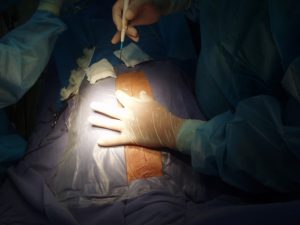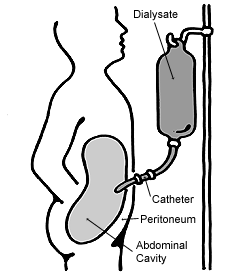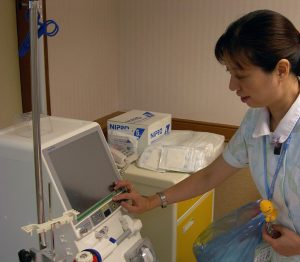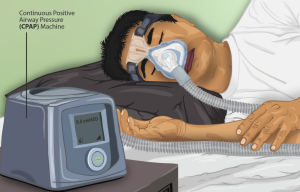1.5 Suffixes
A suffix is a word part that is located at the end of a word. It can alter the meaning of a medical term. It is important to spell and pronounce suffixes correctly. When writing a suffix, if it is not in a medical term, you must place a “-” before the suffix.
Suffixes are not always explicitly stated in the definition of a word, and it is common that suffixes are not explicitly stated when defining a medical term in the workplace. However, when transcribing or reading a medical report, the suffix is always clearly written. In order to properly spell and pronounce medical terms, it is helpful to learn the suffixes. We will review a few common suffixes and terms related to them, and then continue learning about suffixes in Chapter 2.
Table 1.7. Suffixes
| SUFFIXES | MEANING | EXAMPLE OF USE IN MEDICAL TERMS |
|---|---|---|
| -algia | condition of pain | arthralgia |
| -cision | process of cutting | incision |
| -dipsia | thirst | polydipsia |
| -ectomy | removal, excision, cutting out | appendectomy |
| -gram | record | mammogram |


Key Concepts
Incisions are done for many reasons, and Fig. 1.10 is an image of surgeon making an abdominal incision. The surgeon could possibly be doing an exploratory laparotomy or some form of resection. Incision has the suffix -cision, which means “process of cutting.”
Mammograms are a common diagnostic procedure, and Fig. 1.11 is an image of a mammogram being performed. Breast tissue goes on the film plate, then the X-ray machine above produces an image of the breast tissue. Mammograms are done routinely as a way of diagnosing, or ruling out, breast cancer. The term mammogram has the suffix -gram, meaning “record” and mamm/o, meaning “breast,” so the term means “record of the breast.”
Table 1.8. Suffixes
| SUFFIXES | MEANING | EXAMPLE OF USE IN MEDICAL TERMS |
| -graphy | process of recording | electrocardiography |
| -ic | pertaining to | gastric |
| -ine | pertaining to | intrauterine |
| -ism | condition, process | hypothyroidism |
| -itis | inflammation | arthritis |
| -lysis | breakdown, separate | dialysis |


Key Concepts
When a patient’s kidneys are not working effectively, the patient may be placed on dialysis (Kidney Foundation of Canada, 2022). Dialysis literally means “breakdown or separation complete,” which refers to the process of completely breaking down a patient’s blood, removing wastes, and then returning the blood to the patient’s body.
Peritoneal dialysis is shown in Fig. 1.12. This type of dialysis is performed by inserting a catheter into the peritoneal cavity, then instilling a fluid into the area so that wastes can move from the patient’s body into the fluid. Then the fluid is drained back into the bag (Kidney Foundation of Canada, 2022).
Patients undergo dialysis because their kidneys can no longer remove wastes from the body. It is typically used until the patient finds a suitable kidney for transplant (Kidney Foundation of Canada, 2022).
Table 1.9. Suffixes
| Suffix | MEANING | EXAMPLE OF USE IN MEDICAL TERMS |
|---|---|---|
| -mission | to send | remission |
| -mortem | death | postmortem |
| -oma | tumour, mass | hepatoma |
| -opsy | to view | biopsy |
| -osis | abnormal condition | nephrosis |
| -ous | pertaining to | intravenous |
| -partum | birth | antepartum |


Key Concepts
Biopsies are common diagnostic tests. Biopsy samples can be taken from many parts of the human body and are then sent to a lab for analysis; an example is shown in Fig. 1.14. The term biopsy has the suffix -opsy, meaning “to view.”
Fig. 1.15 shows an image of a pregnant women. In medical terms, the time before a women delivers the baby is called antepartum. This term literally means “birth before” or “before birth.” The time after a women delivers a baby is called postpartum, or “after birth.” Both terms have the suffix -partum, meaning “birth.”
Table 1.10. Suffixes
| Suffix | MEANING | EXAMPLE OF USE IN A MEDICAL TERM |
| -pnea | breathing | apnea |
| -rrhea | flow, discharge | rhinorrhea |
| -scope | instrument to visually examine | laparoscope |
| -scopy | process of visual examination | colonoscopy |
| -section | to cut | resection |
| -sis | state of | prognosis |
| -stasis | to stand, to place, to stop | metastasis |
| -stomy | opening | tracheostomy |
| -tension | pressure | hypertension |
| -tomy | process of cutting into | craniotomy |
| -um | structure | pericardium |
| -y | process, condition | dysentery |
Key Concepts
Notice that the suffix -ectomy has the suffix -tomy within it, but they have very different meanings. The suffix -ectomy means “removal of,” whereas the suffix -tomy means “to cut into.”
If a term has the suffix -ectomy, then it always has the meaning “removal of”; for example, nephrectomy means “removal of the kidney.” If you change the suffix to -tomy, making the term nephrotomy, it would mean “to cut into the kidney.” Note that changing the suffix results in the term having two very different meanings.
It is also important to note the difference between -tomy and -stomy because they are both similar. As stated above, the suffix -tomy means “to cut into,” but the suffix -stomy means “opening.” Openings such as a tracheostomy, an opening into the trachea to assist with breathing, or a colostomy, which is often done to assist with conditions such as bowel obstructions, are usually permanent or semi-permanent.


Key Concepts
The term apnea has the suffix -pnea, meaning “breathing.” Fig. 1.16 is an image of a person who has a particular kind of apnea called sleep apnea. If a person has sleep apnea, they sometimes stop breathing while they are sleeping and often awake feeling very tired. A CPAP machine is often prescribed for people who have sleep apnea to ensure that they continue to breath normally during sleep.
Fig. 1.17 shows an arthroscope. Patients often have procedures done with scopes to visually exam parts of the body. The suffix -scope means “an instrument to visually examine,” and in this case, it is being used to examine a “joint” (arthr/o).
Exercise
Exercise
Attribution
Unless otherwise indicated, material on this page has been adapted from the following resource:
Carter, K., & Rutherford, M. (2020). Building a medical terminology foundation. eCampusOntario. https://ecampusontario.pressbooks.pub/medicalterminology/ licensed under CC BY 4.0
References
Kidney Foundation of Canada. (2022). Dialysis. https://kidney.ca/Kidney-Health/Living-With-Kidney-Failure/Dialysis
Image Credits
(Images are listed in order of appearance)
Incisión de Piel by Alexperf, CC BY 3.0
Blausen 0628 Mammogram by BruceBlaus, CC BY 3.0
Peritoneal dialysis by National Kidney and Urologic Diseases Information Clearinghouse, Public domain
HCCH hemodialysis machine by Jackhsiao, Public domain
Punch biopsy by Ajay Kumar Chaurasiya, CC BY-SA 4.0
Pregnant woman by Ken Hammond, Public domain
Depiction of a Sleep Apnea patient using a CPCP machine by myUpchar , CC BY-SA 4.0
Arthroskopie by Ligamentaxis, CC BY-SA 4.0
The condition of pain in the joints
The process of cutting into
Much thirst
Removal of the appendix
A record of the breast
The process of recording the electricity of the heart
Pertaining to the stomach
Pertaining to within the uterus
A condition of low thyroid
Inflammation of the joints
To break down completely, as in kidney dialysis
To send back
Death after or after death
A mass or tumour on the liver
To view life
An abnormal condition of the kidney
Pertaining to within a vein
Before birth
No breathing
Discharge from the nose
An instrument to visually examine the abdomen
The process of visually examining the colon
To cut back
Knowledge before or making a prediction of the outcome
To change place
An incision into the trachea
Pressure that is high; high blood pressure
Cutting into the skull
A structure surrounding the heart
Condition of painful intestines

